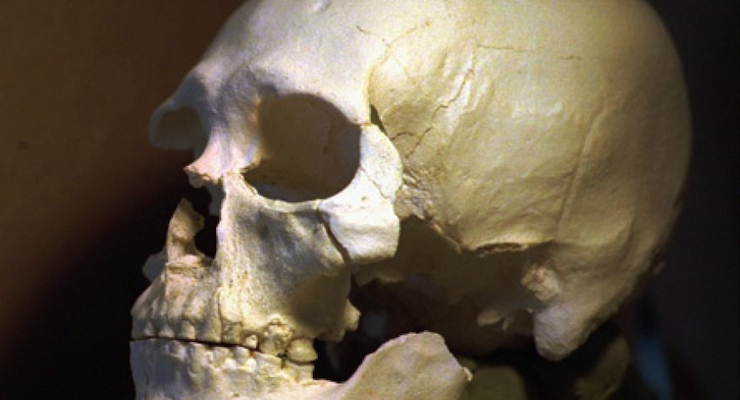

FILE – This July 24, 1997 file photo shows a plastic casting of the skull from the bones known as Kennewick Man in Richland, Wash. The ancient skeleton, found nearly 20 years ago in a river in Washington, is related to Native Americans, says a DNA study published Thursday, June 18, 2015. The finding could help resolve a long-running dispute over its ancestry and custody. (Photo: AP/Elaine Thompson)
A recent DNA analysis of an 8,500-year-old skeleton found in Washington state 19 years ago says the so-called “Kennewick Man” is related to Native Americans, blowing a massive hole in the theory that he arrived from Siberia via a land bridge that used to extend to Alaska.
Researchers relied upon a DNA analysis to try to settle the skeleton’s ancestry after many scientists disputed the theory based on features that didn’t comport with theory. They were able to recover DNA from a fragment of a hand bone and map Kennewick Man’s genetic code. Then, they compared that to modern-day DNA from native peoples of the Americas and various other humans around the world.
The results showed a greater similarity to the DNA structure of natives in the Americas than from anywhere else, with a close relationship to at least one Native American population in Washington. The research, by an international team of scientists, was published online Thursday by the journal Nature.
Kennewick Man was uncovered in 1996 after two men stumbled across part of its skull in the Columbia River near the city of Kennewick in southern Washington.
But the origin of Kennewick Man isn’t the only controversy surrounding the discovery.
Several Native American tribes have asked that the skeleton be handed over to them for reburial, under a 1990 federal law aimed at returning certain Native American cultural items, including human remains, to descendants and culturally affiliated tribes. Their request was set to be granted without incident by the U.S. Army Corps of Engineers, which manages the land where Kennewick Man was found.
However, a group of scientists sued to block the Army Corps of Engineers from doing so, claiming the bones should be kept available for study. In 2004, a federal appeals court agreed with lower court decisions to block the Army from granting the request based on the scientists’ claims that the law did not apply because there was no evidence to connect the remains to any existing tribe.
Still, it isn’t yet clear how the results of the DNA analysis will impact the ruling.
The Washington-based Colville tribe, a Native American group that had filed one of the initial requests, donated DNA to be analyzed, which found that Kennewick Man is “very closely related to the Colville,” said Eske Willerslev of the University of Copenhagen, senior author of the study. Mr. Willerslev said DNA from the other tribes had not been offered for testing yet, but he suspects they are closely related, as well.
Jim Boyd, chairman of the council that governs the Confederated Tribes of the Colville Reservation, said the findings will aid the tribal efforts to rebury the remains.
“We have always maintained the belief that the Ancient One was one of us,” Boyd said, using the tribal term for Kennewick Man.
Doug Owsley, one of the scientists from the Smithsonian Institution’s National Museum of Natural History who sued to block the Army Corps of Engineers, contends the new DNA findings do not sufficiently link the skeleton to the Colville group to justify handing them over under the federal law.
“The results do not tie Kennewick Man exclusively to the Colville,” said Owsley, adding that other data show Kennewick Man was “a traveler…. His people were coming from somewhere else. We don’t know who that people (were), we don’t know what their culture was.”
Willerslev said that until researchers have a more comprehensive collection of DNA samples from native populations in the Americas, they won’t be able to definitely tell what tribe or population Kennewick Man is most closely related to. Yet, despite the Smithsonian’s claim, this isn’t the first time bones have been handed over to a tribe for burial purposes.
Last year, the 12,600-year-old bones of a baby boy found in Montana were reburied in a tribal ceremony after DNA showed links to native peoples.
Brig. Gen. John Kem, commander of the Northwestern Division of the Corps of Engineers, said his staff will analyze the research so he can decide whether to turn the bones over to the tribes. The skeleton is stored at the Burke Museum of Natural History and Culture in Seattle.







